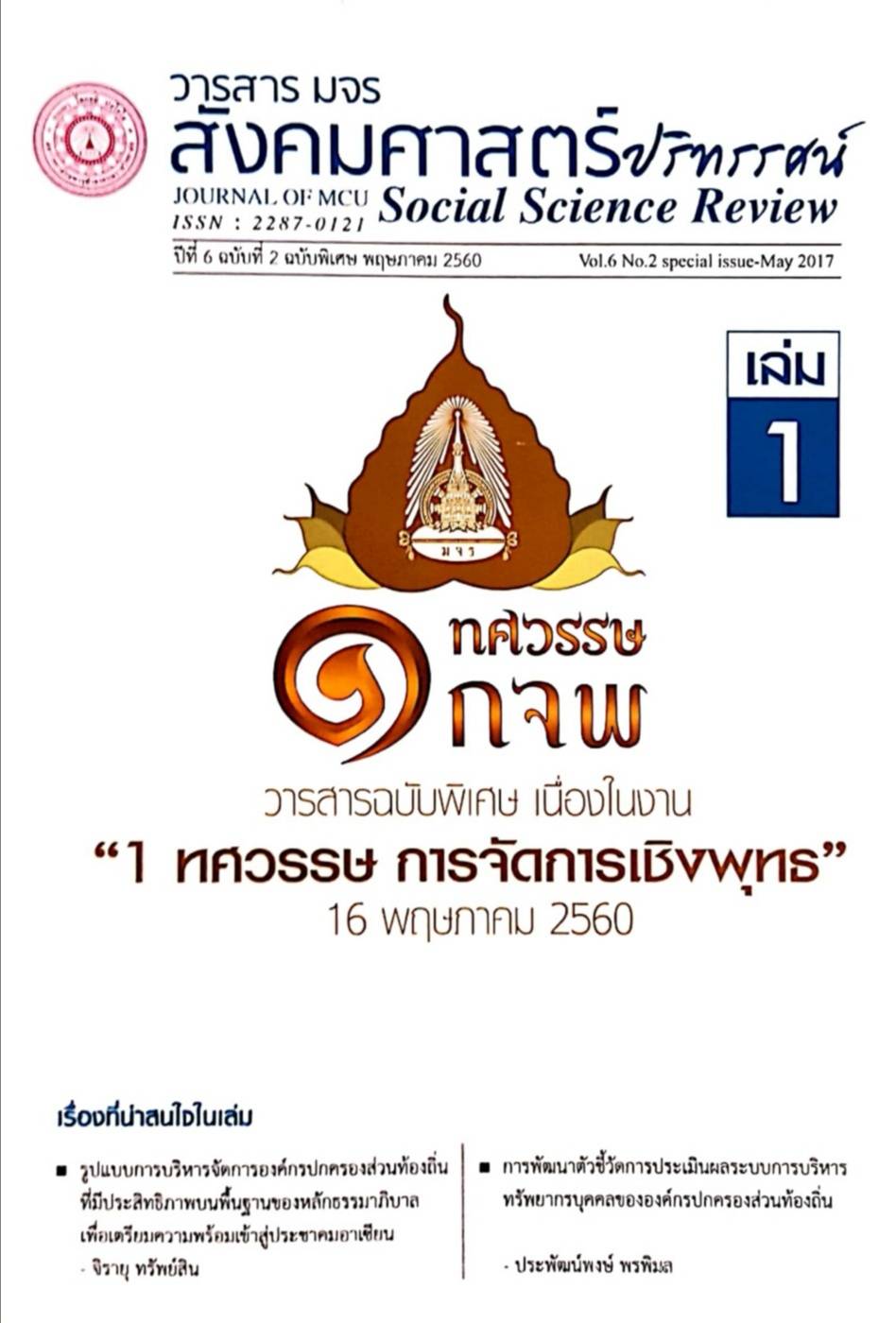รูปแบบความสัมพันธ์เชิงสาเหตุของปัจจัยที่ส่งผลต่อความสามารถในการแข่งขัน ของธุรกิจ OTOP ประเทศไทย
คำสำคัญ:
รูปแบบความสัมพันธ์เชิงสาเหตุ ความสามารถในการแข่งขัน OTOPบทคัดย่อ
การศึกษา “รูปแบบความสัมพันธ์เชิงสาเหตุของปัจจัยที่ส่งผลต่อความสามารถในการแข่งขันของธุรกิจ OTOP ประเทศไทย” เป็นการวิจัยแบบผสมผสาน กลุ่มตัวอย่าง คือ
ผู้ประกอบการ OTOP ประเภทอาหาร ในภาคกลาง 15 จังหวัด จำนวน 480 ราย ผลการวิจัยพบว่า : 1) การวิเคราะห์องค์ประกอบเชิงยืนยัน (CFA) ทั้ง 4 ปัจจัย ได้แก่ ปัจจัยเครือข่ายความร่วมมือ
ปัจจัยสภาวะแวดล้อมในการดาเนินงาน ปัจจัยแรงผลักดันทางธุรกิจ 5 ประการ และปัจจัย ความสามารถในการแข่งขัน แสดงให้เห็นว่าตามการทดสอบเชิงสมมติฐานที่ผู้วิจัยพัฒนาขึ้นผ่าน
เกณฑ์ดัชนีความสอดคล้องกลมกลืนของโมเดลกับข้อมูลเชิงประจักษ์ ซึ่งเป็นไปตามสมมติฐานการวิจัย ที่กำหนดไว้ และรูปแบบความสัมพันธ์เชิงสาเหตุส่งผลทางตรงและทางอ้อม ต่อรูปแบบ
ความสามารถในการแข่งขัน OTOP โดยมีค่าความสัมพันธ์เชิงบวก 2) จากการสัมภาษณ์เชิงลึกเพื่อยืนยันโมเดล พบว่า ปัจจัยที่ผู้ประกอบการต้องพิจารณาในการดำเนินธุรกิจให้มีความสามารถ
ในการแข่งขัน ประกอบด้วย การสร้างผลิตภัณฑ์ให้โดดเด่น การพัฒนาด้านการส่งออกสินค้าไปต่างประเทศ เพิ่มการจัดจาหน่ายสินค้าผ่านเทคโนโลยี รัฐบาลควรส่งเสริมองค์ความรู้ด้านนวัตกรรม
และสร้างเครือข่ายกับหน่วยงานต่าง ๆ และตลาดต่างประเทศให้มากขึ้น วิเคราะห์อุตสาหกรรมที่เกี่ยวข้องในการดาเนินงาน และส่งเสริมองค์ความรู้เกี่ยวกับรูปแบบความสามารถในการแข่งขัน
อย่างยั่งยืน และเหมาะสมกับธุรกิจ OTOP
เอกสารอ้างอิง
มหาวิทยาลัยราชภัฏวไลยลงกรณ์ ในพระบรมราชูปภัมถ์ฯ
ณัฏฐพันธ์ เขจรนันทน์. (2552). การจัดการเชิงกลยุทธ์ (ฉบับปรับปรุงใหม่). กรุงเทพฯ :
ซีเอ็ดยูเคชั่น
ปราณี ตปณียวรวงศ์. (2552). “โมเดลการวิเคราะห์ปัจจัยความสามารถในการ
แข่งขันอุตสาหกรรมส่งออกรองเท้าของไทย.” วิทยานิพนธ์ดุษฏีนิพนธ์ปรัชญาดุษฏี
บัณฑิต (บริหารธุรกิจ) : มหาวิทยาลัยรามคาแหง.
นงลักษณ์ วิรัชชัย. (2538). ความสัมพันธ์โครงสร้างเขิงเส้น (LISREL) สถิติวิเคราะห์สาหรับ
การวิจัยทางสังคมศาสตร์และพฤติกรรมศาสตร์. กรุงเทพฯ : โรงพิมพ์จุฬาลงกรณ์
มหาวิทยาลัย.
สานักงานส่งเสริมวิสาหกิจขนาดกลางและขนาดย่อม (สสว). (1557). โอกาสและผลกระทบ
ของ OTOP กับการเข้าสู่ประชาคมเศรษฐกิจอาเซียน (AEC). กรุงเทพฯ : สสว.
อภิญญา ศักดาศีโรรัตน์. (2550). กลยุทธ์การสร้างศักยภาพการแข่งขันธุรกิจหัตถกรรม :การศึกษาย่านธุรกิจสินค้าหัตถกรรมสันกาแพง จังหวัดเชียงใหม่. วิทยานพนธ์การจัดการ
ดุษฏีบัณฑิต สาขาการจัดการธุรกิจ. กรุงเทพฯ : มหาวิทยาลัยราชภัฏสวนดุสิต.
Michael E. Porter. (1980). Competitive Strategy. New York : Free Press.
Michael E. Porter. (1990). The Competitive Advantage of Nations. New York :
Free Press.
Mukhamad Najib, Farida Ratna Dewi & Hardiana Widtyastuti. (2014).
“Collaborative Networks as a Source of Innovation and Sustainable
Competitiveness for Small and Medium Food Processing Enterprises in
Indonesia.” International Journal of Business and Management. Vol. 9,
No. 9,
ดาวน์โหลด
เผยแพร่แล้ว
รูปแบบการอ้างอิง
ฉบับ
ประเภทบทความ
สัญญาอนุญาต
ลิขสิทธิ์ (c) 2020 วารสาร มจร สังคมศาสตร์ปริทรรศน์

อนุญาตภายใต้เงื่อนไข Creative Commons Attribution-NonCommercial-NoDerivatives 4.0 International License.
เพื่อให้เป็นไปตามกฎหมายลิขสิทธิ์ ผู้นิพนธ์ทุกท่านต้องลงลายมือชื่อในแบบฟอร์มใบมอบลิขสิทธิ์บทความให้แก่วารสารฯ พร้อมกับบทความต้นฉบับที่ได้แก้ไขครั้งสุดท้าย นอกจากนี้ ผู้นิพนธ์ทุกท่านต้องยืนยันว่าบทความต้นฉบับที่ส่งมาตีพิมพ์นั้น ได้ส่งมาตีพิมพ์เฉพาะในวารสาร มจร สังคมศาสตร์ปริทรรศน์ เพียงแห่งเดียวเท่านั้น หากมีการใช้ภาพหรือตารางหรือเนื้อหาอื่นๆ ของผู้นิพนธ์อื่นที่ปรากฏในสิ่งตีพิมพ์อื่นมาแล้ว ผู้นิพนธ์ต้องขออนุญาตเจ้าของลิขสิทธิ์ก่อน พร้อมทั้งแสดงหนังสือที่ได้รับการยินยอมต่อบรรณาธิการ ก่อนที่บทความจะได้รับการตีพิมพ์ หากไม่เป็นไปตามข้อกำหนดเบื้องต้น ทางวารสารจะถอดบทความของท่านออกโดยไม่มีข้อยกเว้นใดๆ ทั้งสิ้น





